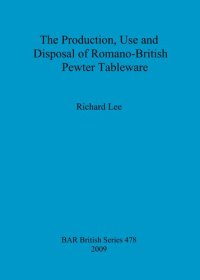
Ebook: The Production, Use and Disposal of Romano-British Pewter Tableware
Author: Richard Lee
- Series: BAR British Archaeological Reports British Series 478
- Year: 2009
- Publisher: BAR Publishing
- Language: English
- pdf
There remains a wide variety of evidence for the production and consumption of tin and lead alloy tableware in Roman Britain. In this book it is the categorisation of Romano-British tin and lead alloy tableware, as well as vessel production moulds, manufacturing debris and compositional data for pewter vessels that forms the study's foundation. Yet it is the main purpose of this book to place this data in a wider social, economic and chronological context. In particular two powerful theoretical perspectives – that social identities could be constructed through the consumption of 'objects', and that such identities can be recorded in an object's depositional context – have informed this research. The main result of this study is that pewter tableware, although a 'Romanized' material, could create and maintain a range of different social identities. Functionally different vessels, for example, can be taken as indicators of different 'lifestyle' choices, the comparative values of which shifted over time. However, these identities could also be re-negotiated over time to suit a number of 'atypical' personal choices, such as the reuse of high status vessels in ritual or low status roles. Another key result is that pewter consumption was also constrained by a comparative absence of tin in Britain before the 3rd century. Limited pre-3rd century pewter production can be suggested as occurring predominantly where there was easy access to imported tin. However, post 3rd century production, although most prolific in regions that had direct access to Cornish tin, could also exist in central and eastern England where they were fuelled by recycled tin, the extent of which is starting to be addressed through compositional analysis of Romano-British pewter. These findings, and the data they are built on, should both contribute to research on Romano-British pewter, and more generally provide new approaches to understand Roman material culture in Britain.